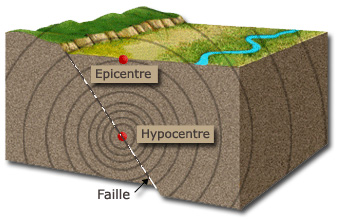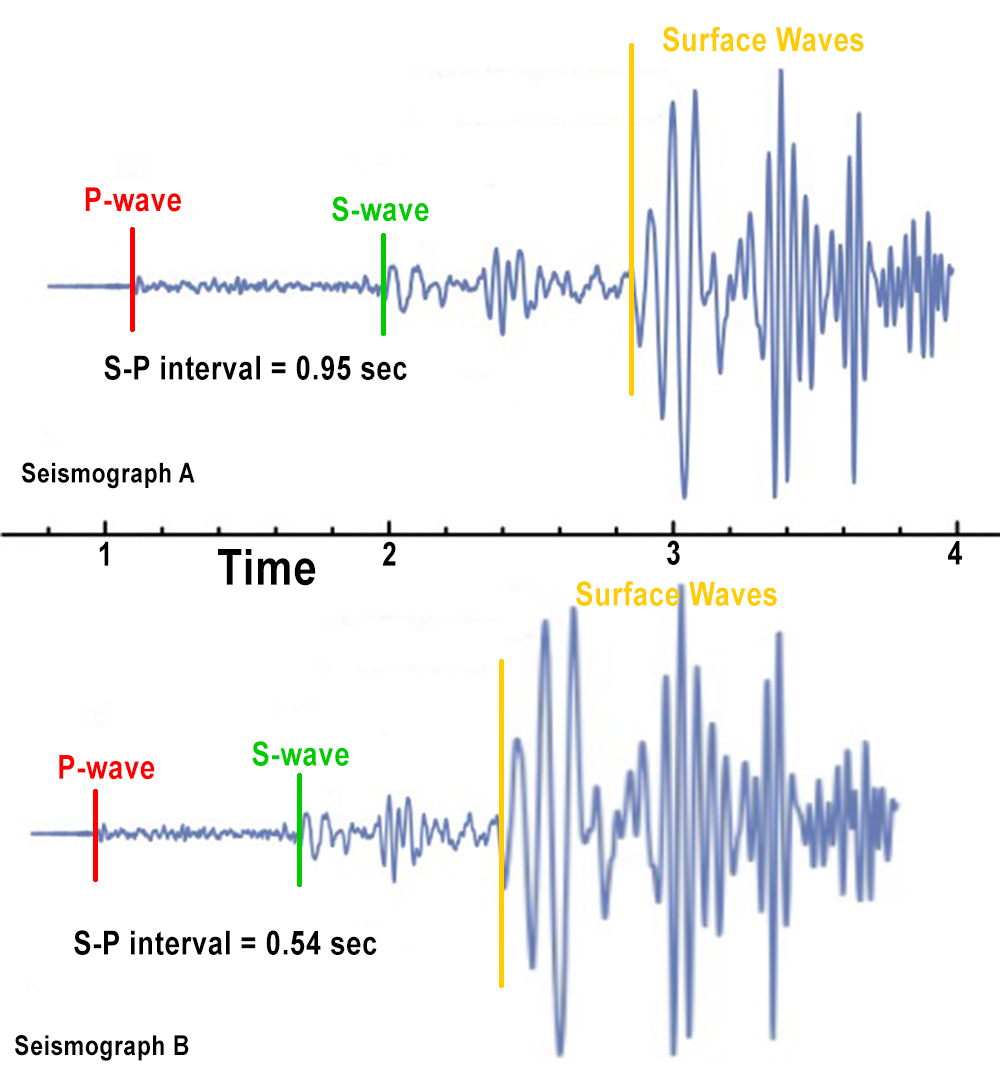
This article is motivated by a physics exam paper in Singapore :
- the 2022 O Level Paper 2 question 8 -
on waves generated by an earthquake.
Earthquakes are natural phenomena that have fascinated and terrified humans for centuries. They occur when there is a sudden release of energy in the Earth’s crust, causing the ground to shake. This release of energy originates from the buildup of stress within the Earth's lithosphere, primarily due to tectonic plate movements. Understanding the physics behind earthquakes can help in predicting and mitigating their impacts, leading to better preparedness and safety measures for people living in earthquake-prone regions. This article explores the fundamental physics of earthquakes, including the causes, processes, energy release, and impact on the Earth's surface.
1. Introduction to Earthquakes
An earthquake is the shaking of the Earth's surface caused by the release of energy from the Earth's crust. This energy release typically occurs due to the movement of tectonic plates, which are massive sections of the Earth's outer shell that move and interact with each other. When two plates meet, they may either move toward each other, away from each other, or slide past each other. In certain conditions, these plates become stuck because of friction. Over time, stress builds up at these boundaries, and once the stress exceeds the strength of the rocks, it is released in the form of seismic waves, which are the vibrations we feel as an earthquake.
Seismic waves spread out in all directions from the point of rupture (also called the focus or hypocenter), causing the ground to move. Earthquakes can vary in intensity, from minor tremors that go unnoticed to massive events that cause significant destruction and loss of life. The magnitude of an earthquake is measured on the Richter scale, while the intensity of the shaking at specific locations is measured using the Modified Mercalli Intensity (MMI) scale.
2. The Physics of Seismic Waves
Seismic waves are the waves of energy that travel through the Earth, and they are classified into two main types: body waves and surface waves.
a) Body Waves
Body waves travel through the Earth's interior and are faster than surface waves. They are further divided into two types:
- Primary (P) Waves: These are compressional waves, meaning they push and pull particles in the same direction as the wave is traveling. As a result, P-waves cause the ground to alternately compress and expand along the direction of wave propagation. P-waves are the fastest seismic waves, moving at speeds between 4 and 8 kilometers per second in the Earth's crust. They are the first to be detected by seismographs because of their speed.
- Secondary (S) Waves: These are shear waves that move perpendicular to the direction of wave propagation. S-waves cause the ground to move up and down or side to side. They are slower than P-waves, with speeds between 2 and 4 kilometers per second. S-waves are more destructive than P-waves because their motion produces larger displacements in the Earth's surface.
b) Surface Wave
Surface waves travel along the Earth's surface and are responsible for most of the damage caused by earthquakes. These waves move slower than body waves but are more destructive due to their larger amplitudes and prolonged duration. There are two main types of surface waves:
• Love Waves: These waves move in a horizontal, side-to-side motion, causing the ground to shift in a serpentine pattern. Love waves are faster than Rayleigh waves but can produce significant horizontal displacement, which can be particularly damaging to structures.
• Rayleigh Waves: These waves move in an elliptical motion, causing both vertical and horizontal ground movement. Rayleigh waves often produce a rolling motion, similar to ocean waves, and are typically the most destructive of the surface waves due to their longer duration and the complexity of their movement.
Seismic waves move at different speeds depending on the material through which they are traveling. The density and elasticity of the Earth's layers determine the velocity of seismic waves. For example, seismic waves travel faster through solid rock than through liquids or gases.

3. The Mechanics of Earthquake Generation
The generation of an earthquake can be understood through the concept of stress and strain within the Earth's crust. Stress is the force exerted on rocks, and strain is the deformation that results from this stress. As tectonic plates move, stress accumulates along faults, which are fractures in the Earth's crust where two blocks of rock have moved relative to each other. The mechanics of fault movement can be described in the following steps:
a) Tectonic Plate Movements
The Earth's lithosphere is divided into several large plates, including the Pacific Plate, the North American Plate, the Eurasian Plate, and the African Plate, among others. These plates are constantly in motion due to the heat-driven process of mantle convection beneath the Earth's crust. The plates move in different directions and interact with each other at their boundaries, resulting in various types of faults.
There are three primary types of plate boundaries:
• Divergent Boundaries: These occur where plates are moving apart. As the plates separate, magma from the mantle rises to fill the gap, forming new crust. This process is typically associated with volcanic activity, but earthquakes can also occur along these boundaries due to the movement of the plates.
• Convergent Boundaries: These occur where plates collide. One plate may be forced beneath another in a process called subduction, creating deep earthquakes. The collision of plates can also result in the folding or uplifting of the crust, which can cause shallow earthquakes.
• Transform Boundaries: These occur where plates slide past each other horizontally. The friction between the plates prevents them from moving smoothly, causing stress to build up over time. When the stress exceeds the frictional strength of the rocks, it is released as an earthquake.
b) Faulting and Stress Accumulation
As plates interact at their boundaries, they exert stress on the rocks at the fault lines. This stress causes the rocks to deform elastically, meaning they change shape but return to their original form when the stress is removed. However, when the stress exceeds the strength of the rocks, the rocks suddenly break or slip along the fault line, causing a release of energy.
This sudden release of energy propagates as seismic waves, which can cause significant shaking of the ground. The point where the fault slips is known as the focus or hypocenter of the earthquake, and the point on the Earth's surface directly above the focus is called the epicenter.
c) Elastic Rebound Theory
The concept of elastic rebound explains the process by which stress builds up along a fault until it is released during an earthquake. According to this theory, the Earth's crust behaves like a stretched elastic material. When stress builds up along a fault, the rocks bend and store potential energy. Eventually, the stress exceeds the strength of the rocks, and they rupture, releasing the stored energy in the form of seismic waves. After the rupture, the rocks return to their original shape, which is known as the "rebound" phase.
The magnitude of an earthquake depends on the amount of stress that has accumulated along the fault and the area of the fault that ruptures. A larger fault rupture releases more energy, resulting in a more powerful earthquake.
4. Measuring Earthquakes
Earthquakes are measured in two primary ways: magnitude and intensity.
a) Magnitude
Magnitude refers to the total energy released by an earthquake, and it is typically measured using the Richter scale or the moment magnitude scale (Mw). The Richter scale, developed by Charles F. Richter in 1935, measures the amplitude of seismic waves recorded by seismographs. However, the moment magnitude scale is now more commonly used, as it provides a more accurate estimate of an earthquake's size by measuring the area of the fault that ruptures, the amount of slip along the fault, and the material properties of the rocks involved.
Each unit increase in magnitude on the Richter scale corresponds to a tenfold increase in amplitude and roughly 32 times more energy released. For example, a magnitude 6 earthquake releases approximately 32 times more energy than a magnitude 5 earthquake.
b) Intensity
Intensity refers to the strength of the shaking experienced at a particular location during an earthquake. The Modified Mercalli Intensity (MMI) scale is commonly used to measure earthquake intensity. The MMI scale ranges from I (not felt) to XII (total destruction). The intensity of an earthquake can vary greatly depending on the distance from the epicenter, the depth of the earthquake, the local geology, and the type of structures in the affected area.
5. The Impact of Earthquakes on the Earth's Surface
The shaking caused by earthquakes can result in a variety of effects on the Earth's surface. These include surface ruptures, ground displacement, landslides, and tsunamis.
a) Surface Rupture
Surface rupture occurs when the fault that caused the earthquake reaches the Earth's surface. The ground may crack or shift along the fault, causing displacement. The extent of surface rupture depends on the size of the earthquake and the type of fault. In some cases, surface ruptures can cause significant damage to roads, buildings, and infrastructure.
b) Ground Displacement
Ground displacement refers to the movement of the ground as a result of an earthquake. The amount of displacement can vary depending on the size of the earthquake, the type of fault, and the depth of the rupture. Displacement can cause damage to structures, roads, and pipelines, and in extreme cases, it can lead to the formation of new landforms such as fault scarps.
c) Landslides and Liquefaction
Earthquakes can trigger landslides, especially in mountainous areas. The shaking can dislodge rocks and soil, leading to landslides that can bury communities or block roads. In areas with loose, water-saturated soils, the shaking can cause liquefaction, where the ground behaves like a liquid, leading to the collapse of structures and infrastructure.
d) Tsunamis
Underwater earthquakes, especially those that occur along subduction zones, can generate tsunamis. These are large ocean waves that are caused by the displacement of the seafloor. When the seafloor suddenly rises or drops during an earthquake, the overlying water is displaced, generating waves that travel across the ocean. When these waves reach coastal areas, they can cause devastating flooding and damage.
6. Conclusion
The physics of earthquakes involves the complex interactions between tectonic plates, stress accumulation, and the release of energy in the form of seismic waves. Understanding these processes helps scientists study and predict earthquakes, although the exact timing and location of major seismic events remain difficult to predict. Earthquakes can have significant impacts on the Earth's surface, causing ground displacement, landslides, and tsunamis, but with the advancement of technology and research, we are better equipped to mitigate the risks and reduce the damage caused by these powerful natural phenomena.
You can learn these concepts and more at Dr Hock's maths and physics tuition.